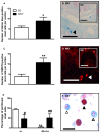Disodium cromoglycate reverses colonic visceral hypersensitivity and influences colonic ion transport in a stress-sensitive rat strain
- PMID: 24367692
- PMCID: PMC3867510
- DOI: 10.1371/journal.pone.0084718
Disodium cromoglycate reverses colonic visceral hypersensitivity and influences colonic ion transport in a stress-sensitive rat strain
Abstract
The interface between psychiatry and stress-related gastrointestinal disorders (GI), such as irritable bowel syndrome (IBS), is well established, with anxiety and depression the most frequently occurring comorbid conditions. Moreover, stress-sensitive Wistar Kyoto (WKY) rats, which display anxiety- and depressive-like behaviors, exhibit GI disturbances akin to those observed in stress-related GI disorders. Additionally, there is mounting preclinical and clinical evidence implicating mast cells as significant contributors to the development of abdominal visceral pain in IBS. In this study we examined the effects of the rat connective tissue mast cell (CTMC) stabiliser, disodium cromoglycate (DSCG) on visceral hypersensitivity and colonic ion transport, and examined both colonic and peritoneal mast cells from stress-sensitive WKY rats. DSCG significantly decreased abdominal pain behaviors induced by colorectal distension in WKY animals independent of a reduction in colonic rat mast cell mediator release. We further demonstrated that mast cell-stimulated colonic ion transport was sensitive to inhibition by the mast cell stabiliser DSCG, an effect only observed in stress-sensitive rats. Moreover, CTMC-like mast cells were significantly increased in the colonic submucosa of WKY animals, and we observed a significant increase in the proportion of intermediate, or immature, peritoneal mast cells relative to control animals. Collectively our data further support a role for mast cells in the pathogenesis of stress-related GI disorders.
Conflict of interest statement
Figures




Similar articles
-
Early-life stress selectively affects gastrointestinal but not behavioral responses in a genetic model of brain-gut axis dysfunction.Neurogastroenterol Motil. 2015 Jan;27(1):105-13. doi: 10.1111/nmo.12486. Epub 2014 Dec 2. Neurogastroenterol Motil. 2015. PMID: 25443141
-
Prostaglandin E2, Produced by Mast Cells in Colon Tissues From Patients With Irritable Bowel Syndrome, Contributes to Visceral Hypersensitivity in Mice.Gastroenterology. 2020 Jun;158(8):2195-2207.e6. doi: 10.1053/j.gastro.2020.02.022. Epub 2020 Feb 19. Gastroenterology. 2020. PMID: 32084424 Free PMC article.
-
GPER-mediated, oestrogen-dependent visceral hypersensitivity in stressed rats is associated with mast cell tryptase and histamine expression.Fundam Clin Pharmacol. 2020 Aug;34(4):433-443. doi: 10.1111/fcp.12537. Epub 2020 Feb 6. Fundam Clin Pharmacol. 2020. PMID: 31967341
-
Colorectal distension-induced prefrontal cortex activation in the Wistar-Kyoto rat: implications for irritable bowel syndrome.Neuroscience. 2010 Feb 3;165(3):675-83. doi: 10.1016/j.neuroscience.2009.08.076. Epub 2009 Sep 16. Neuroscience. 2010. PMID: 19765638
-
Dexamethasone prevents visceral hyperalgesia but not colonic permeability increase induced by luminal protease-activated receptor-2 agonist in rats.Gut. 2007 Aug;56(8):1072-8. doi: 10.1136/gut.2006.115352. Epub 2007 Feb 19. Gut. 2007. PMID: 17309885 Free PMC article.
Cited by
-
Downregulation of mucosal mast cell activation and immune response in diarrhoea-irritable bowel syndrome by oral disodium cromoglycate: A pilot study.United European Gastroenterol J. 2017 Oct;5(6):887-897. doi: 10.1177/2050640617691690. Epub 2017 Jan 29. United European Gastroenterol J. 2017. PMID: 29026603 Free PMC article.
-
GPR35 agonists inhibit TRPA1-mediated colonic nociception through suppression of substance P release.Pain. 2025 Mar 1;166(3):596-613. doi: 10.1097/j.pain.0000000000003399. Epub 2024 Oct 3. Pain. 2025. PMID: 39382322 Free PMC article.
-
Endogenous oxytocin exerts anti-nociceptive and anti-inflammatory effects in rats.Commun Biol. 2022 Sep 5;5(1):907. doi: 10.1038/s42003-022-03879-8. Commun Biol. 2022. PMID: 36064593 Free PMC article.
-
Stress and the Microbiota-Gut-Brain Axis in Visceral Pain: Relevance to Irritable Bowel Syndrome.CNS Neurosci Ther. 2016 Feb;22(2):102-17. doi: 10.1111/cns.12490. Epub 2015 Dec 10. CNS Neurosci Ther. 2016. PMID: 26662472 Free PMC article. Review.
-
Peripheral mechanisms contribute to comorbid visceral hypersensitivity induced by preexisting orofacial pain and stress in female rats.Neurogastroenterol Motil. 2020 Jul;32(7):e13833. doi: 10.1111/nmo.13833. Epub 2020 Mar 10. Neurogastroenterol Motil. 2020. PMID: 32155308 Free PMC article.
References
Publication types
MeSH terms
Substances
LinkOut - more resources
Full Text Sources
Other Literature Sources
Medical

